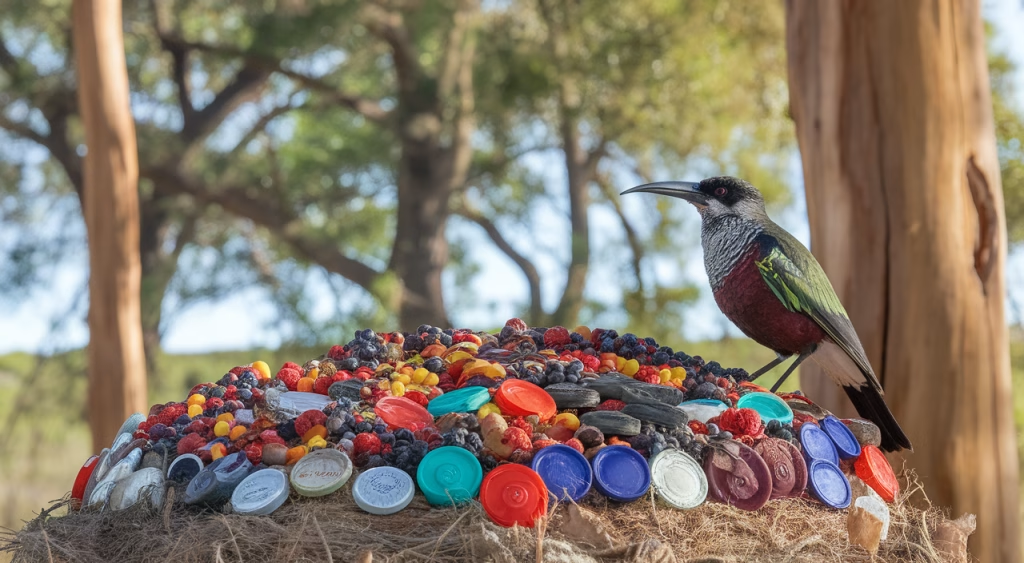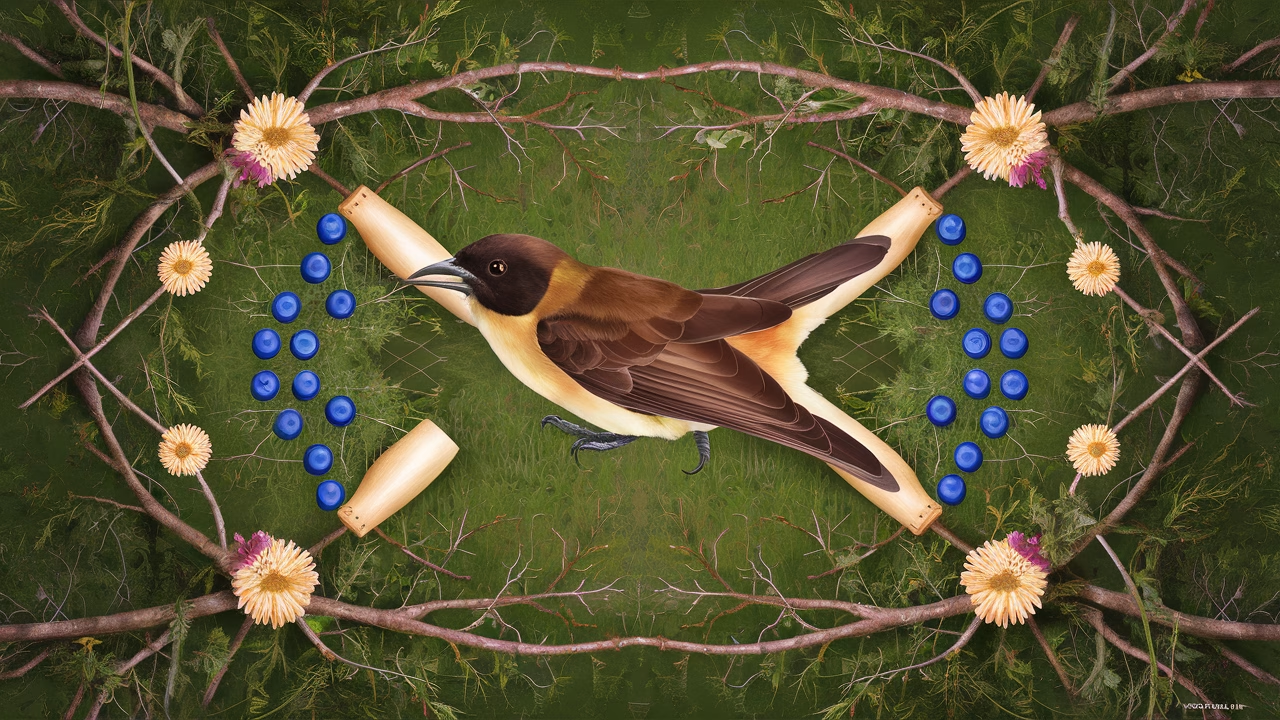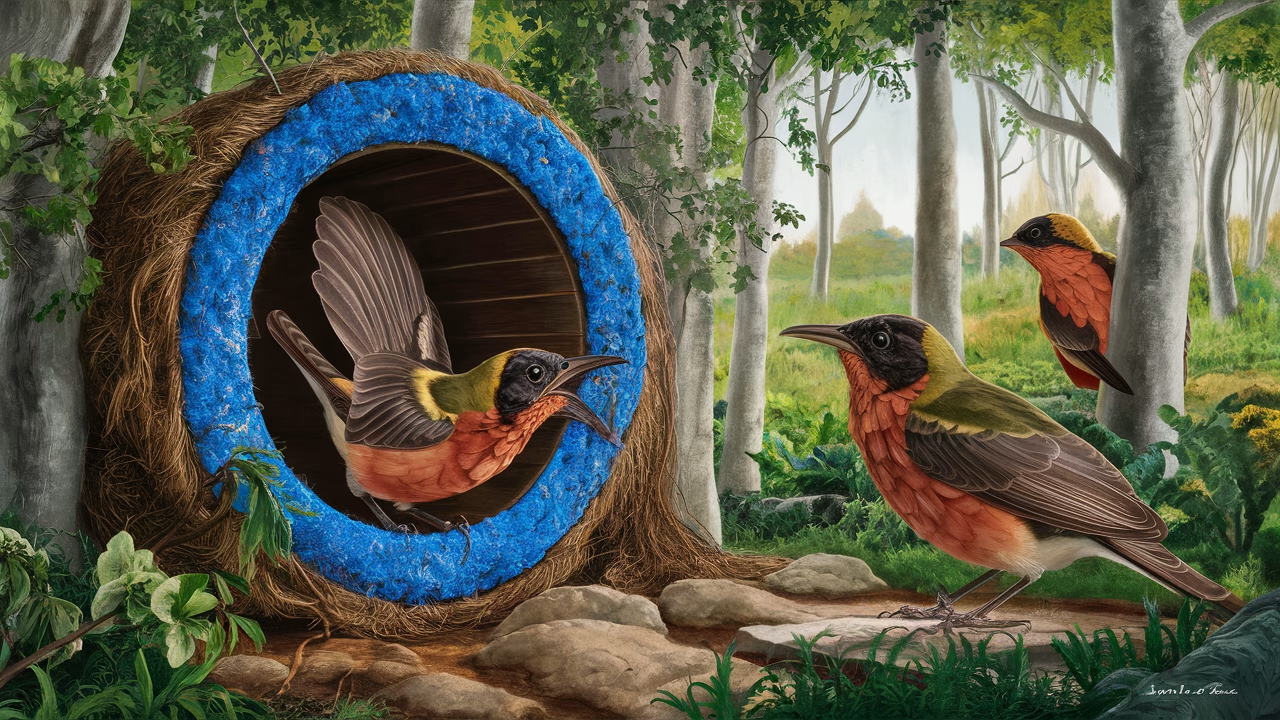Why Do Male Bowerbirds Decorate Nests with Colorful Objects?
Male bowerbirds decorate their nests—or more precisely, their bowers—as part of an intricate courtship ritual that’s among nature’s most fascinating displays. These colorful, carefully curated structures serve one powerful purpose: to attract and impress female bowerbirds. Through elaborate decoration and performance, male bowerbirds showcase their fitness, creativity, and genetic quality to potential mates.
TL;DR: The Art of Attraction — Bowerbird Nest Decorations Summary
- Purpose: Male bowerbirds decorate nests as a courtship display to attract female mates, not for nesting eggs.
- Materials Used: Decorations include flowers, berries, feathers, beetle shells, plastic bits, and more—often in vibrant blues, purples, and greens.
- Species Variation: Over 20 species show differing styles—satin bowerbirds favor blue items, while MacGregor’s bowerbirds use mossy tunnels.
- Behavioral Insight: Decorations are strategic; arranged symmetrically to manipulate female perception of size and symmetry, often hinting at intelligence and health.
- Scientific Significance: A model of sexual selection and cognitive evolution, bowerbird rituals help scientists understand animal perception and aesthetic sensibilities.
What Makes a Bowerbird’s Bower Different from a Nest?
Let’s clarify a common misconception: The structure male bowerbirds build isn’t a traditional “nest”—it’s a performance stage designed specifically for bird mating rituals. While females later construct traditional nests in trees to lay and incubate eggs, the male’s bower is an exclusive showcase of courtship ingenuity.
These bowerbird nests come in two primary architectural styles:
- Avenue-type bowers: Built like twin vertical walls made of twigs with a pathway in between for dancing displays. Common among species like the satin bowerbird.
- Maypole-type bowers: Constructed around a vertical stick or sapling, often enclosed by a canopy of leaves or moss. This is typical in species like the golden bowerbird.
Both types are adorned with meticulously chosen decorations arranged to dazzle the discerning female visitors. It’s not random—spacing, color palettes, and patterns are essential parts of the game.
How Different Species Decorate: A Look Inside their Artistic Choices
Each male bowerbird species showcases its unique aesthetic, shaped by evolution and habitat availability. The satin bowerbird, for instance, demonstrates particularly striking nest decoration preferences.
| Species | Preferred Decoration | Bower Style |
|---|---|---|
| Satin Bowerbird | Bright blue objects, bottle caps, flowers | Avenue |
| Vogelkop Bowerbird | Moss, fruits, beetle elytra, plastic bits | Maypole |
| MacGregor’s Bowerbird | Large hanging moss tunnels, lichens | Maypole |
| Flame Bowerbird | Red berries, black stones | Avenue |
Each bower is a distinctive work of art, shaped by local materials, aesthetic preference, and the behavioral impulses that evolution has enhanced over time.
The Science Behind Female Choice: What Are Females Looking For?
Female bowerbirds are incredibly selective when evaluating these elaborate bird mating rituals—and for good reason. They’re choosing the father of their future offspring, influencing the genes passed down to their chicks and potentially the survival of the next generation.
So, what makes male bowerbirds and their decorated structures appealing?
- Color vibrancy: Bright, consistent colors display signs of health. For satin bowerbirds, a preference for blue reflects their ability to acquire rare, vivid materials.
- Symmetry and arrangement: Females prefer bowers with neatly arranged items—suggesting precision and cognitive ability.
- Performance quality: Male bowerbirds often perform elaborate dances and vocalizations within their bowers—bringing sound and motion into the mix.
- Lack of parasites: Healthier males with cleaner bowers signal better genes.
In this sense, decorating isn’t just vanity—it’s advertising intelligence, survival skills, and fertility through sophisticated bowerbird mating rituals.
Deception, Trickery, and Evolution at Play
Nature doesn’t always play fair in the world of male bowerbirds. Some males employ forced perspective—strategically placing larger objects at the back and smaller ones up front. This creates a visual illusion, making their decorations appear uniformly sized and their bower more symmetrical. It’s visual manipulation in bird mating rituals!
Some studies even show that younger or less successful male bowerbirds may sabotage rival bowers—stealing or destroying artwork like jealous vandals. Evolution rewards winners, and in the high-stakes arena of bowerbird courtship, every advantage counts.
Lessons from One of Nature’s Most Artistic Courtships
Male bowerbirds challenge many of our assumptions about animals and aesthetics. Their actions beg deeper questions: Can animals have a sense of beauty? Is this innate or learned?
Watching a satin bowerbird obsess over the placement of each blue object reveals a glimpse into avian cognition. He’s not just decorating bowerbird nests—he’s making complex decisions informed by trial, observation, and instinct.
Satin Bowerbirds and the Blue Obsession: Why Blue?
Satin bowerbirds, striking in their iridescent blue-black feathers, have a particular fixation: blue objects for their nest decorations. From plastic straws to wildflowers, they hunt down anything with a blue hue. Why?
Research suggests blue strongly contrasts against their forest habitat and highlights the blue sheen of the male satin bowerbird himself. It’s compositional harmony in bird mating rituals—an avian sense of fashion that enhances their courtship success.
The female, less vibrantly colored, is the judge—visiting various bowers, examining décor, and watching displays before selecting her mate. It’s survival of the fanciest in the world of male bowerbirds.
Cost of Courtship: What Does it Take to Build a Bower?
If you’re picturing a quick collection of trinkets, think again. Crafting and maintaining bowerbird nests takes weeks—even months. Male bowerbirds spend countless hours gathering, arranging, and defending their art installations.
Costs include:
- Time loss: Time spent building means less time feeding or hiding from predators.
- Risk: Brightly colored bowers can draw predators.
- Energy: The physical and cognitive demands of performance and constant maintenance.
Still, the evolutionary payoff—reproduction—is powerful enough to drive this incredible behavior. In the world of male bowerbirds, life’s a stage, and they’re always performing.
Final Thoughts: What Can We Learn from Bowerbirds?
Male bowerbirds don’t build to survive—they build to seduce. Their captivating displays speak to a world where beauty, creativity, and innovation aren’t just human traits but essential elements of bird mating rituals.
If you’re a nature lover, birdwatcher, or simply fascinated by animal behavior, the world of bowerbird nests offers lessons in courtship, cognition, and evolutionary art. These remarkable male bowerbirds remind us that the dance between attraction and survival stretches far beyond our species, creating some of nature’s most spectacular displays.
Frequently Asked Questions
Why do male bowerbirds decorate their nests?
They decorate to attract mates. Female bowerbirds select partners based on the beauty, symmetry, and creativity of the male’s decorative display.
Do all bowerbirds use the same materials?
No. Materials vary by species and local availability. Some prefer natural items like feathers and fruits, others incorporate man-made materials like plastic or glass.
Is the decorated nest used as the actual nest for raising chicks?
No. The decorated structure is only used in mating displays. Females build the real nest for laying eggs after choosing a mate.
What happens to the bowers after mating season?
Some males abandon them, while others reuse or rebuild them yearly. Bowers are often rebuilt or enhanced to improve future success.
How do female bowerbirds judge the bowers?
They judge based on color intensity, object symmetry, male performance, and cleanliness—all signs of good genes and health.
Why do satin bowerbirds prefer blue?
Blue stands out sharply in their green forested environment and complements the male’s plumage, enhancing visual impact during courtship.
Do any males cheat or steal decorations?
Yes, theft and sabotage are surprisingly common behaviors as males try to undercut rivals and increase their own chances of attracting a mate.





